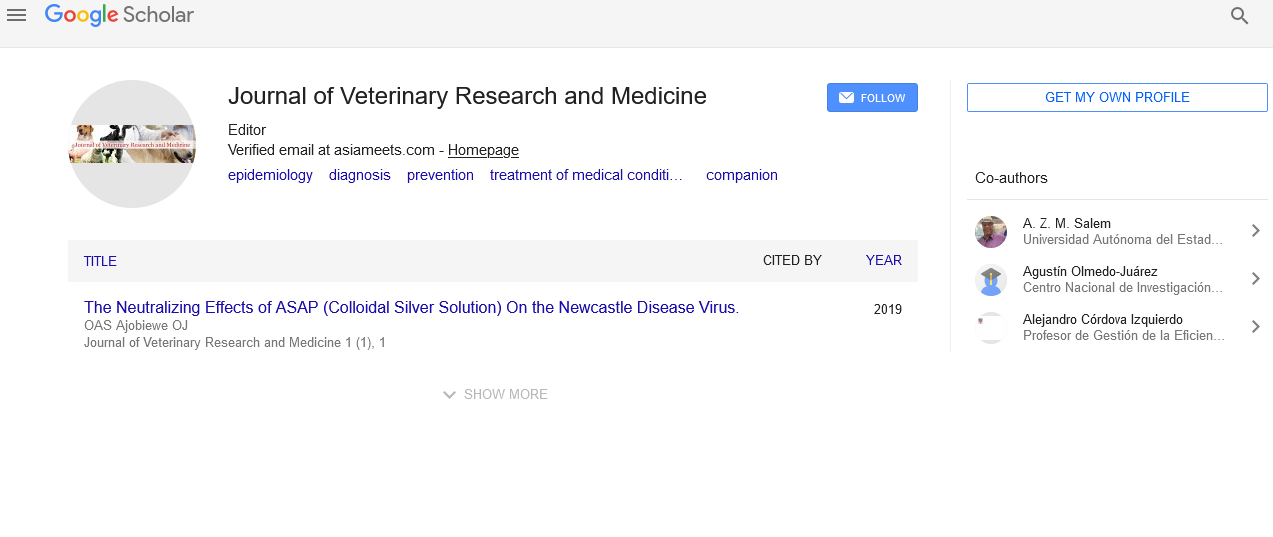Equine Syndrome
Received: 17-Feb-2022, Manuscript No. PULJVRP-22-4274; Editor assigned: 21-Feb-2022, Pre QC No. PULJVRP-22-4274(PQ); Accepted Date: Mar 03, 2022; Reviewed: 23-Feb-2022 QC No. PULJVRP-22-4274; Revised: 28-Feb-2022, Manuscript No. PULJVRP-22-4274(R); Published: 07-Mar-2022
This open-access article is distributed under the terms of the Creative Commons Attribution Non-Commercial License (CC BY-NC) (http://creativecommons.org/licenses/by-nc/4.0/), which permits reuse, distribution and reproduction of the article, provided that the original work is properly cited and the reuse is restricted to noncommercial purposes. For commercial reuse, contact reprints@pulsus.com
Abstract
Equine general medication might be a veterinary specialty submitted to the investigation of pony illnesses barring the people who need careful activity and productive problems. Equine enteral medication might be a term that incorporates the examination and treatment of illnesses of the inside frameworks, as well as the aviation routes, heart, cerebrum, liver, digestive organs and kidneys. Lower aviation route irritation (“hurls”) is incredibly normal in ponies that pay a large portion of their time in slows down, altogether if ventilation is poor and matter burden is high. This ailment joins a complex an etiology anyway antipathies for indrawn antigens, regularly foreign substances of feedstuffs (roughage) and bedding, play a genuine job.
Key Words
Veterinary; Equine; Anthelmintic
Introduction
Cartilaginous cylinder breadth diminishes as a result of irritation, fit and an ascent in intraluminal discharges, which by and large are thick and tacky. Impacted ponies show breath side effect, hack and ought to have nasal release. Clinical signs typically repeat that has LED to the name of consistent aviation route impediment. Assignment depends on respiratory organ tuning in (wheezes and snaps), assessment (expansion in cartilaginous cylinder mucous discharge, clyster of the carina) and unusual natural science discoveries in metastasis emissions (rise in white blood corpuscle count) acquired by Broncho alveolar water system. Our expert’s clinicians can play out a cautious and intensive examination of your pony to help check what extra tests are likewise fundamental. Our emergency clinic is absolutely prepared, with radiant offices and moderate instrumentality open to adjust our vets to make a right assignment of your pony or horse’s condition. These meds are best directed through inward breath.
Background
Fiery Airway Dullness (IAD) might be a comparable anyway less serious condition that influences youthful competitors and which can address beginning phases of RAO. Lungworms (for example Dictyocaulus runway) may end in comparative clinical pitons to RAO or IAD. Doubt of parasitic respiratory organ ailment is additionally brought up in ponies that offer fields with jackasses (repository) or in ponies with high eosinophil include metastasis emissions. Clinical determination depends on ID of the parasites or their eggs (in metastasis emissions or in faces). Treatment depends on the work of anthelmintic.
Equine Peptic Ulcer Syndrome (EGUS) has 2 particular presentations in ponies that affect grown-ups and foals, severally. The tissue layer of the equine midsection has 2 sections: non-glandular and organ. Most equine ulcers are found inside the non-glandular segment.
Conclusion
In grown-up pony’s stomach ulcers are normally connected with pressure and diet. Persistent organization of no steroidal mitigating medication moreover plays an undertaking inside the advancement of organ stomach ulcers. EGUS is normally found in sport ponies that get high energy takes care of which pay a large portion of their time wrapped in slows down. Clinical signs maybe very expansive including: torment, remittent weight, teeth crushing, the runs, conduct changes, and so on assignment depends on investigation assessment of the midsection. Treatment incorporates the board a large number ponies mend basically while being put at field and, when vital, medication that stifle corrosive creation inside the stomach: nucleon siphon inhibitors (for example omeprazole), and meds that tight spot the undesirable tissue layer.





